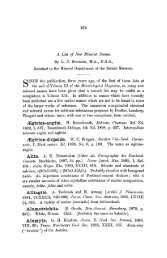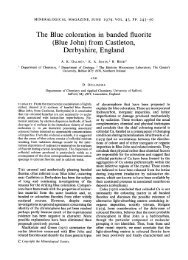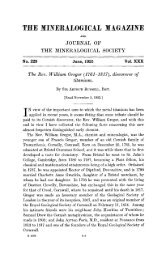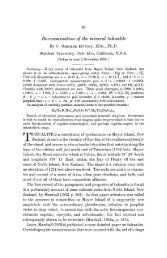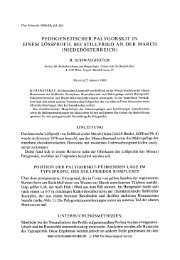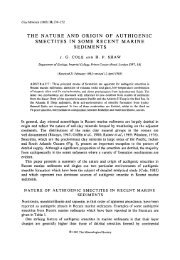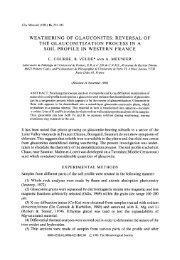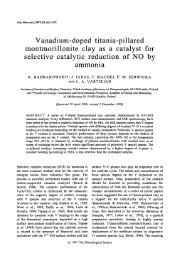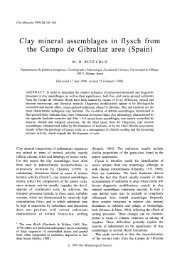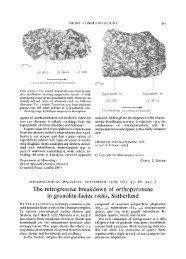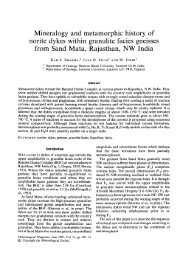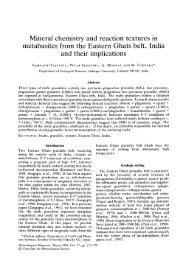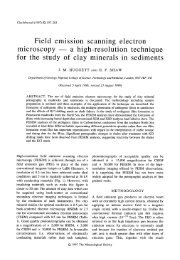Jadeite-K-feldspar rocks and jadeitites northwest Turkey from
Jadeite-K-feldspar rocks and jadeitites northwest Turkey from
Jadeite-K-feldspar rocks and jadeitites northwest Turkey from
You also want an ePaper? Increase the reach of your titles
YUMPU automatically turns print PDFs into web optimized ePapers that Google loves.
<strong>Jadeite</strong>-K-<strong>feldspar</strong> <strong>rocks</strong> <strong>and</strong> <strong>jadeitites</strong><br />
<strong>northwest</strong> <strong>Turkey</strong><br />
<strong>from</strong><br />
ARAL I. OKAY<br />
iTO, Maden Fakiiltesi, Jeoloji Brliimii, Ayaza~a 80624, lstanbul, <strong>Turkey</strong><br />
Abstract<br />
Blueschist-facies <strong>rocks</strong> with jadeite--K-<strong>feldspar</strong>-lawsonite paragenesis occur as exotic blocks in Miocene<br />
debris flows in the blueschist belt of <strong>northwest</strong> <strong>Turkey</strong>. The jadeite-K-<strong>feldspar</strong> <strong>rocks</strong> have a very fme grain<br />
size <strong>and</strong> although recrystallized locally retain a relict porphyritic volcanic texture. The former nepheline<br />
microphenocrysts, recognized <strong>from</strong> their characteristic shapes, are pseudomorphed by jadeite <strong>and</strong> K-<strong>feldspar</strong>,<br />
while the relict magrnatic aegirine has rims of jadeite. The matrix of the rock consists of very fine-grained<br />
aggregates of jadeite, K-<strong>feldspar</strong> <strong>and</strong> lawsonite. In some blocks, jadeite makes up >60% of the mode. <strong>Jadeite</strong>,<br />
K-<strong>feldspar</strong> <strong>and</strong> lawsonite in the blocks are essentially pure end-member in composition. P-T estimates for<br />
these <strong>rocks</strong> are 8 _+ 2 kbar <strong>and</strong> 300 __+ 50~ The preserved volcanic texture, relict aegirine <strong>and</strong> the bulk rock<br />
composition indicate that these <strong>rocks</strong> represent metamorphosed phonolites. The paragenesis in these <strong>rocks</strong><br />
shows that jadeite-K-<strong>feldspar</strong> is a stable mineral pair in blueschist-facies P-T conditions.<br />
KEVWORDS: jadeite, K-<strong>feldspar</strong>, lawsonite, jadeitite, blueschist, <strong>Turkey</strong>.<br />
Introduction<br />
THE paragenesis jadeite + K-<strong>feldspar</strong> is not recorded<br />
<strong>from</strong> blueschist-facies <strong>rocks</strong>. In the eclogite-facies it is<br />
reported <strong>from</strong> metamorphosed acidic magmatic <strong>rocks</strong><br />
<strong>from</strong> the Western Alps (Lef'evre <strong>and</strong> Michard, 1965;<br />
Saliot, 1979; Compagnoni <strong>and</strong> Maffeo, 1973; Biino<br />
<strong>and</strong> Compagnoni, 1992) <strong>and</strong> <strong>from</strong> New Caledonia<br />
(Black et al., 1988). Compagnoni <strong>and</strong> Maffeo (1973)<br />
<strong>and</strong> Biino <strong>and</strong> Compagnoni (1992) regard K-<strong>feldspar</strong><br />
in eelogite-faeies metagranites as a metastable relic<br />
<strong>from</strong> the igneous parent <strong>and</strong> inherently unstable in the<br />
eclogite facies. Here, I describe jadeite-K-<strong>feldspar</strong><br />
<strong>rocks</strong> <strong>from</strong> bluesehist-facies metaphonolites <strong>from</strong><br />
<strong>northwest</strong> <strong>Turkey</strong>. In some of these <strong>rocks</strong>, jadeite<br />
comprises >60 modal per cent, justifying the title<br />
jadeitite. Like <strong>jadeitites</strong> <strong>from</strong> Burma (Lacroix, 1930)<br />
<strong>and</strong> Guatemala (Harlow, 1994), the jadeite-K-<strong>feldspar</strong><br />
<strong>rocks</strong> <strong>from</strong> <strong>northwest</strong> <strong>Turkey</strong> are commercially<br />
utilized <strong>and</strong> exported as jades. However, unlike these<br />
classical <strong>jadeitites</strong>, which occur as blocks in<br />
serpentinite <strong>and</strong> have a largely metasomatic origin,<br />
jadeite-K-<strong>feldspar</strong> <strong>rocks</strong> <strong>from</strong> <strong>northwest</strong> <strong>Turkey</strong> are<br />
found as blocks in the Miocene debris flows <strong>and</strong><br />
represent metamorphosed phonolites.<br />
The jadeite-K-<strong>feldspar</strong> <strong>rocks</strong> occur in the western<br />
part of the Tav~anh Zone of <strong>northwest</strong> <strong>Turkey</strong>. The<br />
Mineralogical Magazine, December 1997, VoL 61, pp. 835-843<br />
0 Copyright the Mineralogical Society<br />
Tav}anh Zone is a 50-60 km wide <strong>and</strong> 300 km long<br />
tectonic belt of blueschist, volcano-sedimentary<br />
complex <strong>and</strong> ophiolite (Okay, 1984). Bluesehists<br />
represent a coherent continental margin to platform<br />
sequence of metapelites, metapsammites, marbles,<br />
metabasites <strong>and</strong> metacherts. The depositional age of<br />
the protoliths to the blueschists is probably Paleozoic<br />
to Mesozoic, while the age of metamorphism, based<br />
on Ar/Ar laser probe dating, is Late Cretaceous<br />
(Okay <strong>and</strong> Kelley, 1994; Harris et al., 1994). The<br />
blueschists are tectonically overlain by a Cretaceous<br />
volcano-sedimentary complex <strong>and</strong> large peridotite<br />
slabs. The volcano-sedimentary complex consists of<br />
marie volcanic <strong>and</strong> volcanoclastic <strong>rocks</strong>, radiolarian<br />
cherts, pelagic shales <strong>and</strong> serpentinites, <strong>and</strong> represents<br />
a Cretaceous oceanic accretionary complex.<br />
Blueschists, the accretionary complex <strong>and</strong> peridotite<br />
are unconformably overlain by Miocene terrigenous<br />
sedimentary <strong>and</strong> volcanic <strong>rocks</strong>.<br />
Geological setting<br />
<strong>Jadeite</strong>-K-<strong>feldspar</strong> <strong>rocks</strong> occur in the Bekta~lar<br />
region, west of the town of Harmanclk <strong>and</strong> 60 km<br />
south of Bursa (Fig. 1). The area shows the typical<br />
tectonostratigraphy of the Tav~anll Zone with<br />
coherent blueschists at the base, tectonieally overlain
836 A.I. OKAY<br />
Ed~" r<br />
Black<br />
Sea<br />
m ~<br />
Be"I~s~ area shown<br />
Ankara<br />
V<br />
V V<br />
V<br />
V V<br />
Sv<br />
V<br />
V<br />
9<br />
V<br />
V<br />
V<br />
V<br />
~ = 1 _z;<br />
30[ v v v " ~ ~<br />
~'~v~v v v<br />
V V V V<br />
A ~ ~<br />
V V V<br />
v<br />
~atlar<br />
v<br />
V V V<br />
V<br />
V<br />
V<br />
y<br />
Bedding<br />
Foliation<br />
Smatigraphic<br />
contact<br />
NOrmal Fault<br />
etachment,Z<br />
Fault<br />
~LSip~ai|er:l..: -.::.-::'.::-'<br />
9 ~: ..::..::,.::::::~6:" 48..0...(<br />
.:..S..I:-.;:..S.:m'.:~..::'-I:"<br />
)!iiii!)i!iii!iii ? 7-:il<br />
' ...~.~176176176176 o.....<br />
~a g$~gweleioQ<br />
ii!?ii)iiiiiiii!!<br />
~176176176176<br />
-~Alluvium<br />
~ Mioccnc sediments<br />
~Blueschist metabasite,<br />
I I metashale<br />
m Sample location<br />
-- Pcridotitc ~-~ Basalt, chert, shale i<br />
~ Blueschist marble<br />
0 1 2km<br />
V'dlage i i I<br />
F~G. 1. Geological map of the Bekta~lar region, <strong>northwest</strong> <strong>Turkey</strong>. Locations of the analysed samples are shown. The<br />
inset shows the regional setting of the area studied.
JADEITE-K-FELDSPAR ROCKS FROM TURKEY 837<br />
BLUESCHISTS<br />
Volcano-sedimentary complex<br />
NW<br />
SE<br />
A metabasite Miocene sediments Peridofite A"<br />
i marble / I Debris flow with I<br />
v~-v- v 7-7 v ,, v v v<br />
i<br />
I<br />
I<br />
21ma<br />
FIG. 2. Geological cross-section of the Bekta~lar region. For location of the cross-section see Fig. 1. The thickness of<br />
the Miocene debris flow is greatly exaggerated for clarity.<br />
by the volcano-sedimentary complex <strong>and</strong> peridotite<br />
slabs (Figs. 1, 2). Miocene terrigeneous deposits lie<br />
unconformably over the older units. Blueschists in<br />
the region are made up of white massive marbles<br />
overlain by metabasites with some metashales<br />
(Fig. 1). The volcano-sedimentary complex consists<br />
predominantly of marie volcanic <strong>and</strong> voleaniclastic<br />
<strong>rocks</strong> (>70%) with minor radiolarian chert, pelagic<br />
shale <strong>and</strong> serpentinite. It is cut by large number of<br />
shear zones <strong>and</strong> forms an imbricate thrust stack. The<br />
peridotite lies with a sharp, low-angle fault contact<br />
over both the blueschists <strong>and</strong> the accretionary<br />
complex (Figs 1, 2). It is made up of harzburgite<br />
with dunite b<strong>and</strong>s <strong>and</strong> chromite lenses.<br />
<strong>Jadeite</strong>-K-<strong>feldspar</strong> <strong>rocks</strong> are found as exotic<br />
blocks in the Miocene sedimentary sequence. The<br />
Miocene <strong>rocks</strong> in the region consist of mainly<br />
lacustrine marl, s<strong>and</strong>stone <strong>and</strong> shale. They have<br />
been dated palaeontologicaUy as Middle Miocene<br />
(Kavu~an, 1984). Below subhorizontally bedded,<br />
undisturbed Miocene lacustrine marls, there is a ~6<br />
m thick, poorly cemented, chaotic breccia horizon<br />
well exposed along a road section (Fig. 3). The<br />
breccia layer consists of very poorly sorted, matrix<br />
supported blocks ofblueschist, peridotite, marble <strong>and</strong><br />
jadeite--K-<strong>feldspar</strong> rock in a mudstone/s<strong>and</strong>stone<br />
matrix. The size of the clasts ranges <strong>from</strong> 3 m<br />
down to a few mm with jadeite-K-<strong>feldspar</strong> <strong>rocks</strong><br />
forming the largest blocks (Fig. 3). The very poor<br />
sorting <strong>and</strong> chaotic mixing of the blocks, <strong>and</strong> lack of<br />
internal layering, suggest that the breccias represent<br />
debris flows. <strong>Jadeite</strong>-K-<strong>feldspar</strong>, blueschist, marble<br />
<strong>and</strong> peridotite clasts, <strong>from</strong> the same or an overlying<br />
debris flow, occur as loose or half-buried boulders in<br />
the fields covering several hundred square meters on<br />
either side of the Ba~alan stream (Fig. 1). The<br />
farmers have carried most of these blocks to the<br />
margins of their fields <strong>and</strong> have used them to make<br />
stone wails. All the exported jadeite--K-<strong>feldspar</strong><br />
<strong>rocks</strong> come <strong>from</strong> these stone walls or <strong>from</strong> the<br />
boulders in the fields.<br />
Two lines of evidence indicate that the debris flow,<br />
<strong>and</strong> hence the jadeite-K-<strong>feldspar</strong> blocks, came <strong>from</strong><br />
west of the Sipahiler fault, a major north-trending<br />
normal fault, which forms the contact between the<br />
Miocene <strong>rocks</strong> <strong>and</strong> the blueschists (Figs 1, 2). First,<br />
all the different block rock types, with the exception<br />
of jadeite-K-<strong>feldspar</strong> <strong>rocks</strong>, can be identified in the<br />
region west of the Sipahiler fault, whereas the<br />
blueschists are not exposed to the east of the fault<br />
(Figs 1 & 2). Second, the breccias are restricted to<br />
within 3 km of the Sipahiler fault <strong>and</strong> are not<br />
reported <strong>from</strong> the extensive Miocene deposits <strong>from</strong><br />
farther east. The debris flows may have been<br />
triggered by Miocene earthquake activity along the<br />
Sipahiler fault. Similar earthquake-generated debris<br />
flows have been described <strong>from</strong> active faults (e.g.,<br />
Keller, 1986). However, a careful search for in situ<br />
jadeite-K-<strong>feldspar</strong> <strong>rocks</strong> to the west of the Sipahiler<br />
fault was fruitless, suggesting that such <strong>rocks</strong> are<br />
completely eroded.<br />
FIG. 3. Field photograph of the Miocene debris flow. The<br />
white blocks in the centre are the jadeite-K-<strong>feldspar</strong><br />
<strong>rocks</strong>. Note the hammer below centre for scale.
838 A.I.O~Y<br />
Petrology <strong>and</strong> mineral chemistry<br />
The jadeite-K-<strong>feldspar</strong> <strong>rocks</strong> form very tough, white,<br />
pale green to purple <strong>rocks</strong> with a very fine-grained,<br />
homogeneous texture. Samples <strong>from</strong> 34 individual<br />
blocks were petrographically examined. They consist<br />
of jadeite, K-<strong>feldspar</strong>, lawsonite <strong>and</strong> aegirine, which<br />
comprise >80 % of the mode (Table 1) with very<br />
minor quartz, monazite, phengite <strong>and</strong> secondary<br />
sericite. The non-foliated, fine-grained texture of<br />
these <strong>rocks</strong> is largely inherited <strong>from</strong> the volcanic<br />
protolith. This is beautifully illustrated in Fig. 4a,<br />
where former nepheline microphenocrysts, recognized<br />
<strong>from</strong> their square <strong>and</strong> hexagonal shapes, are set<br />
in a groundmass of jadeite <strong>and</strong> very-free grained<br />
aggregates (
JADEITE-K-FELDSPAR ROCKS FROM TURKEY 839<br />
FIG. 4. Plane polarized photomicrographs of the jadeite-K-<strong>feldspar</strong> <strong>rocks</strong>. (a) Relict magmatic aegirine (ae)<br />
associated with K-<strong>feldspar</strong> (k) <strong>and</strong> jadeite (jd). Notice the square <strong>and</strong> hexagonal shape of the former nepheline<br />
microphenocrysts (sample 4802E). (b) Prismatic aegirine (ae) topotactically replaced by jadeite (jd) associated with<br />
K-<strong>feldspar</strong> (k) <strong>and</strong> jadeite (jd) (sample 47071). (c) Bundles of curved aegirine crystals (ae) set on a fine-grained<br />
matrix of jadeite <strong>and</strong> albite. Notice the regular jadeite-albite grain boundaries suggesting that they form an<br />
equilibrium pair. Aegirine is topotactically replaced by jadeite (sample 4806C). (d) Fine-grained, brownish pink<br />
aggregates of jadeite (jd) associated with lawsonite (lw) <strong>and</strong> K-<strong>feldspar</strong> (k) (sample 4671A).<br />
Fic. 5. Photomicrograph of jadeitite with interlocking<br />
prismatic grains of jadeite (jd) <strong>and</strong> interstitial quartz (q)<br />
(sample 4811A).<br />
operating conditions for the microprobe were 15 kV<br />
accelerating voltage, 15 nA beam current <strong>and</strong> 10 ~tm<br />
beam size. Representative mineral compositions are<br />
given in Table 2. The structural formula of jadeite<br />
was calculated on the basis of six oxygens; the jadeite<br />
end-member was taken to be equal to A1 v', aegirine to<br />
Na-A1 v~, <strong>and</strong> the rest was assigned to augite. The<br />
structural formula of aegirine was calculated on the<br />
basis of four cations, with the same end-member<br />
calculation as in jadeite.<br />
<strong>Jadeite</strong> occurs as individual crystals in the matrix,<br />
<strong>and</strong> as rims on aegirine. In both modes of occurrence<br />
it contains >90% jadeite end-member <strong>and</strong> many<br />
crystals are essentially pure end-member jadeite<br />
(Table 2). The striking pink colour of many<br />
jadeite-K-<strong>feldspar</strong> <strong>rocks</strong> comes <strong>from</strong> jadeite, which<br />
is commonly pale brownish pink in thin-section. The<br />
origin of the colour of jadeite is unclear but may be<br />
related to the trace elements in the mineral (el.
840 A.I. OKAY<br />
~ ~ 1 7 6 ~ ~ ~ ~ o~ ~,~<br />
w<br />
9 ~ _ ooc~.~ c~cSc~ c5c~c5c5o v~<br />
oo<br />
P:'O~ oo ,~-<br />
. . . . . t'q 0 O~<br />
(J<br />
~o<br />
o~ o,~oo oo, o o<br />
0o-- .~oc~c5 c~c5oc~c5<br />
0,'-,0000 0<br />
ooC~ ~c5c5c5 c5c5c~c5c5 ~F<br />
0<br />
9 . .o ooooo o<br />
0<br />
8<br />
9 . 0 0 0 0 0 0 , '<br />
9 9 0 . '<br />
0 ~ 0 0 0 0<br />
0<br />
0<br />
c~<br />
LO<br />
",d"<br />
00~ .~0<br />
~ < ~ ~ z ~<br />
++ ~ .~'~<br />
~ ~ -~ ~ ~ ~ ~ ~ ~ ~ ~
m<br />
JADEITE-K-FELDSPAR ROCKS FROM TURKEY 841<br />
Table 3). Aegirine has >90% aegirine end-member;<br />
pyroxenes with intermediate jadeite contents appear<br />
not to have formed during the HP/LTmetamorphism.<br />
K-<strong>feldspar</strong> always forms cryptocrytalline aggregates.<br />
Compositionally it is also very pure with very minor<br />
(1%) albite <strong>and</strong> anorthite components (Table 2).<br />
Albite <strong>and</strong> lawsonite are also close to their ideal endmember<br />
compositions (Table 2). The composition of<br />
the sericitic white micas with low Si pfu (per formula<br />
unit) (Table 2) indicates that, in contrast to the<br />
phengite with 3.45 Si pfu, they have formed during<br />
the low-pressure alteration of K-<strong>feldspar</strong>.<br />
Pressure-temperature conditions of<br />
metamorphism<br />
The critical blueschist-facies mineral assemblage in<br />
the jadeite-K-<strong>feldspar</strong> <strong>rocks</strong> is jadeite + K-<strong>feldspar</strong><br />
_+ lawsonite + albite. The jadeite + albite<br />
paragenesis constrains the metamorphic pressure<br />
between 5 <strong>and</strong> 9 kbar at 300~ on the basis of the<br />
reactions (Fig. 6):<br />
albite = jadeite + quartz<br />
jadeite = nepheline + albite<br />
In the presence of H20 the estimate for the<br />
minimum pressure increases to 6 kbar based on the<br />
reaction (Manghnani, 1970):<br />
jadeite + H20 = analcite<br />
The Si content of the phengite, ~3.45 pfu<br />
(Table 2), gives a minimum pressure estimate of 9<br />
kbar at 300~ based on the experimentally calibrated<br />
phengite barometer of Massone <strong>and</strong> Schreyer (1987).<br />
Estimates of metamorphic temperature are more<br />
uncertain <strong>and</strong> depend on the H20 activity. The very<br />
fine-grained texture of the jadeite-K-<strong>feldspar</strong> <strong>rocks</strong><br />
may be indicative of dry recrystallization. However,<br />
the quartz + lawsonite veins <strong>and</strong> the presence of<br />
lawsonite in the matrix indicates that at least some<br />
1-120 was available during the HP/LT metamorphism.<br />
For unit H20 activity, the jadeite + lawsonite<br />
assemblage indicates temperatures
842 A.I. OKAY<br />
albite, which is >12 kbar at 400~ (Fig. 6).<br />
Blueschist metapelites with metre-thick layers of<br />
jadeitite of quartz, jadeite <strong>and</strong> phengite, interpreted<br />
as metamorphosed acidic flows, occur 30 km to the<br />
<strong>northwest</strong> of the Bekta~lar region (Okay <strong>and</strong> Kelley,<br />
1994). Equilibrium between glaucophane, chloritoid<br />
<strong>and</strong> jadeite in these sodic metapelites indicates<br />
blueschist-facies P-T conditions of 20 __+ 2 kbar<br />
<strong>and</strong> 430 + 30~ (Okay <strong>and</strong> Kelley, 1994). The in<br />
situ blueschists in the Bekta~lar region form the<br />
eastward continuation of the same metamorphic belt<br />
<strong>and</strong> similar P-T conditions may be assumed for the<br />
<strong>jadeitites</strong> <strong>and</strong> metabasites in the Bekta~lar area.<br />
In terms of metamorphic grade the jadeite-<br />
K-<strong>feldspar</strong> <strong>rocks</strong> are intermediate between the<br />
regional blueschists <strong>and</strong> the volcanosedimentary<br />
sequence. It is possible that they have have formed<br />
a discrete tectonic slice between these two units (of.<br />
Figs 1, 2), which was completely eroded during the<br />
Miocene.<br />
Discussion <strong>and</strong> conclusions<br />
The protoliths to the <strong>jadeitites</strong> must have been very<br />
fine-grained, silica-undersaturated, alkaline volcanic<br />
<strong>rocks</strong>. A whole rock XRF-analysis of a jadeite-K<strong>feldspar</strong><br />
rock is given in Table 3. SiOz, A1203, Na/O<br />
<strong>and</strong> K20 comprise >94 wt.% of the rock. In terms of<br />
major <strong>and</strong> trace element chemistry the rock is a<br />
phonolite (e.g. Le Maitre, 1976; Cox et al., 1979).<br />
The geochemistry <strong>and</strong> petrography of the rock<br />
suggests that it must have initially consisted mainly<br />
of aegirine, nepheline <strong>and</strong> sanidine/anorthoclase. The<br />
following metamorphic reactions are inferred:<br />
sanidine/anorthoclase + H20 = K-<strong>feldspar</strong> + jadeite<br />
+ lawsonite + quartz<br />
nepheline + quartz = jadeite + K-<strong>feldspar</strong><br />
The initial K-<strong>feldspar</strong> must have been sanidine or<br />
anorthoclase. The recrystallization of K-<strong>feldspar</strong> to<br />
cryptocrytalline aggregates may have been due to<br />
conversion of sanidine to microcline. The close<br />
association of K-<strong>feldspar</strong>, jadeite <strong>and</strong> lawsonite (el.<br />
Fig. 4) indicates that this mineral paragenesis is<br />
stable in blueschist-facies conditions. The rarity of K-<br />
<strong>feldspar</strong> in blueschist-facies <strong>rocks</strong> is due to the<br />
unusual rock compositions required to form this<br />
mineral. Unlike albite, K-<strong>feldspar</strong> is stable at crustal<br />
temperatures up to 25 kbar (Seki <strong>and</strong> Kennedy, 1964;<br />
Huang <strong>and</strong> Wyllie, 1974), when it reacts with H20 to<br />
form K-<strong>feldspar</strong>-hydrate.<br />
In situ bluesehist-facies metaphonolites are not<br />
known <strong>from</strong> the Tav~anh Zone <strong>and</strong> are apparently<br />
unrecorded <strong>from</strong> blueschist-facies <strong>rocks</strong> worldwide.<br />
Phonolites with their high alkali <strong>and</strong> A1 contents are<br />
volcanic <strong>rocks</strong> restricted to the continental crust. That<br />
they are metamorphosed in blueschist facies, is one<br />
more example that blueschist metamorphism is not<br />
restricted to oceanic subduction zones but occurs<br />
commonly during the continental subduction.<br />
Acknowledgements<br />
This work was supported by TUBJTAK 227/G <strong>and</strong><br />
TOBJTAK-Glotek grants. The microprobe work was<br />
conducted, while I was a guest in Ecole Normale<br />
Superieure in Paris, for which I thank Christian<br />
Chopin. I thank John Clemens for a thorough review,<br />
T. Fockenberg for the XRF analyses, G.E. Harlow for<br />
drawing my attention to these <strong>rocks</strong>, <strong>and</strong> S. Klrlko~glu<br />
for help in locating the jadeite-K-<strong>feldspar</strong> <strong>rocks</strong> in<br />
<strong>northwest</strong> <strong>Turkey</strong>.<br />
References<br />
Biino, G.G. <strong>and</strong> Compagnoni, R. (1992) Very-high<br />
pressure metamorphism of the Brossasco coronite<br />
metagranite, southern Dora Maira Massif, Western<br />
Alps. Schweiz. Mineral. Petrogr. Mitt., 72, 347-63.<br />
Black, P. M., Brothers, R.N. <strong>and</strong> Yokoyama, K. (1988)<br />
Mineral parageneses in eclogite-facies metaacites in<br />
northern New Caledonia. In Eclogites <strong>and</strong> Eclogite-<br />
Facies Rocks (D.C. Smith, ed.), Elsevier, 271-89.<br />
Compagnoni, R. <strong>and</strong> Maffeo, B. (1973) <strong>Jadeite</strong>-bearing<br />
metagranites 1.s. <strong>and</strong> related <strong>rocks</strong> in Mount<br />
Mucrone area (Sesia-Lanzo Zone, Western Italian<br />
Alps). Schweiz. Min. Pert. Mitt., 53, 355-78.<br />
Cox, ICG., Bell, J.D. <strong>and</strong> Pankhurst, R.J. (1979) The<br />
Interpretation of Igneous Rocks. George Allen &<br />
Unwin, 450pp.<br />
Harlow, G. E. (1994) Jadeitites, albitites <strong>and</strong> related<br />
<strong>rocks</strong> <strong>from</strong> the Matagua Fault Zone, Guatemala. J.<br />
Metam. Geol., 12, 49-68.<br />
Harris, N.B.W., Kelley, S.P. <strong>and</strong> Okay, A.I. (1994) Postcollisional<br />
magmatism <strong>and</strong> tectonics in <strong>northwest</strong><br />
Anatolia. Contrib. Mineral. Petrol., 117, 241-52.<br />
Holl<strong>and</strong>, T.J.B. <strong>and</strong> Powell, R. (1990) An enlarged <strong>and</strong><br />
updated internally consistent thermodynamic dataset<br />
with uncertainties <strong>and</strong> correlations: the system K~O-<br />
Na20-CaO-MgO-MnO-FeO-Fe203-A1203-TiO2-<br />
SIO2-C-H20-O2. J. Metam. Geol., 8, 89-124.<br />
Huang, W.L. <strong>and</strong> Wyllie, P. (1974) Melting relations of<br />
muscovite with quartz <strong>and</strong> sanidine in the K20-<br />
A1203-SiO2-H20 system to 30 kbars <strong>and</strong> an outline<br />
of paragonite melting relations. Amer. J. Sci., 274,<br />
378-95.<br />
Kavu~an, G. (1984) Geologie der Jungtertii~ren<br />
Braunkohlenbecken yon Burmu-Civili-Sagtrlar,<br />
Harmanctk mad Keles (nordwest-Anatolien). Ph.D.<br />
thesis, Universitiit Bonn, Germany, 159 pp.<br />
Keller, E.A. (1986) Investigation of active tectonics:<br />
Use of surficial earth processes. In Active Tectonics,<br />
National Academy Press, Washington D.C., 136-47.<br />
Lacroix, M. A. (1930) La jad6ite de Birmanie: les roches
JADEITE-K-FELDSPAR ROCKS FROM TURKEY 843<br />
qu'elle constitue ou qui l'accompagnent.<br />
Composition et origine. Bull. Soc. franq. Mineral.,<br />
53, 216-54.<br />
Lef~vre, R. <strong>and</strong> Michard, A. (1965) La jad6ite clans le<br />
m6tamorphisme alpin, ~ propos des gisements de<br />
type nouveau, de la b<strong>and</strong>e d'Acceglio (Alpes<br />
cottiennes, Italic). Bull. Soc. franq. Minbral.<br />
Cristallogr., 38, 664-77.<br />
Le Maitre, R.W. (1976) The chemical variability of<br />
some common igneous <strong>rocks</strong>. J. Petrol., 17,<br />
589-637.<br />
Manghnani, M.H. (1970) Analcime-jadeite phase<br />
boundary. Physics Earth Planet. Inter., 3, 456-61.<br />
Massonne, H-J. <strong>and</strong> Schreyer, W. (1987) Phengite<br />
geobarometry based on the limiting assemblage with<br />
K-<strong>feldspar</strong>, phlogopite, <strong>and</strong> quartz. Contrib. Mineral<br />
PetroL, 96, 212-24.<br />
Okay, A.I. (1980) Mineralogy, petrology <strong>and</strong> phase<br />
relations of glaucophane-lawsonite zone blueschists<br />
<strong>from</strong> the Tav~anh region, <strong>northwest</strong> <strong>Turkey</strong>. Contrib.<br />
Mineral. PetroL, 72, 243-55.<br />
Okay, A.I. (1982) Incipient blueschist metamorphism<br />
<strong>and</strong> metasomatism in the Tav~anh region, <strong>northwest</strong><br />
<strong>Turkey</strong>. Contrib. Mineral Petrol., 79, 361-7.<br />
Okay, A.I. (1984) Distribution <strong>and</strong> characteristics of the<br />
<strong>northwest</strong> Turkish bluesehists. In The Geological<br />
Evolution of the Eastern Mediterranean (A.H.F.<br />
Robertson <strong>and</strong> J.E. Dixon, eds.), Geological Society<br />
of London Special Publication No. 17, 455-66.<br />
Okay A.I. <strong>and</strong> Kelley, S.P. (1994) Tectonic setting,<br />
petrology <strong>and</strong> geochronology of jadeite + glaucophane<br />
<strong>and</strong> chloritoid + glaucophane schists <strong>from</strong><br />
<strong>northwest</strong> <strong>Turkey</strong>. J. Metam. GeoL, 12, 455-66.<br />
Saliot, P. (1979) La jad6ite dans les Alpes fran~alses.<br />
Bull MineraL, 102, 391-401.<br />
Seki, Y. <strong>and</strong> Kennedy, C. (1964) The breakdown of<br />
potassium <strong>feldspar</strong> KA1Si308 at high temperatures<br />
<strong>and</strong> pressures. Amer. MineraL, 49, 1688-706.<br />
Woolley, A.R., Platt, R.G. <strong>and</strong> Eby, G.N. (1996)<br />
Relatively aluminous alkali pyroxene in nepheline<br />
syenites <strong>from</strong> Malawi: Mineralogical response to<br />
metamorphism in alkaline <strong>rocks</strong>. Canad. MineraL,<br />
34, 423-34.<br />
[Manuscript received 27 November 1996:<br />
revised 9 June 1997]



